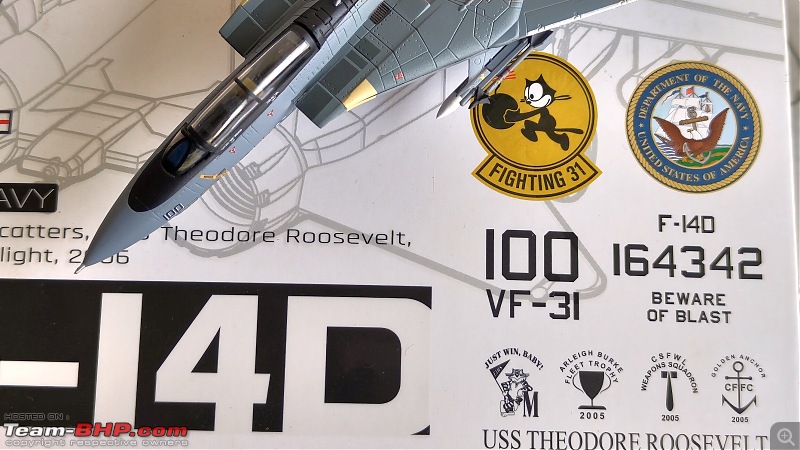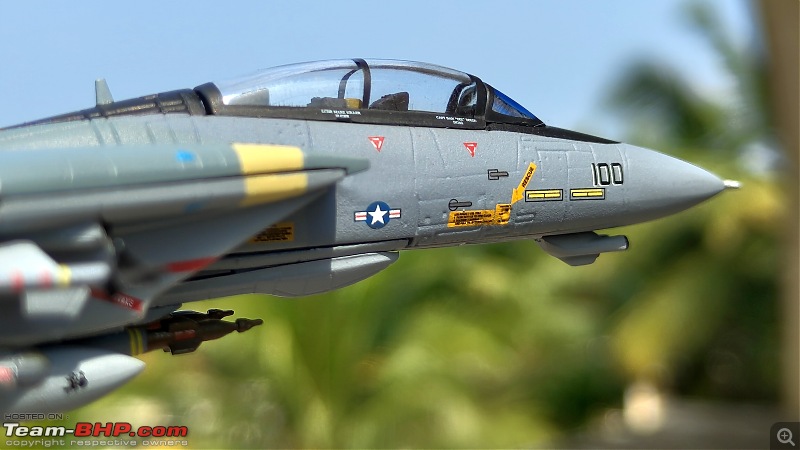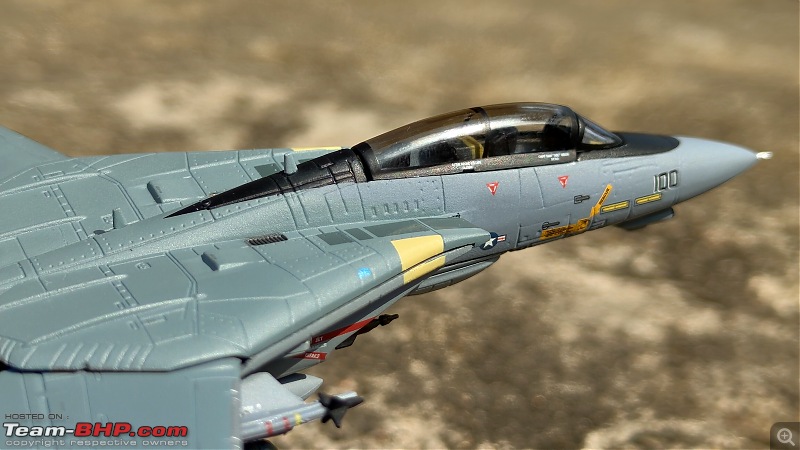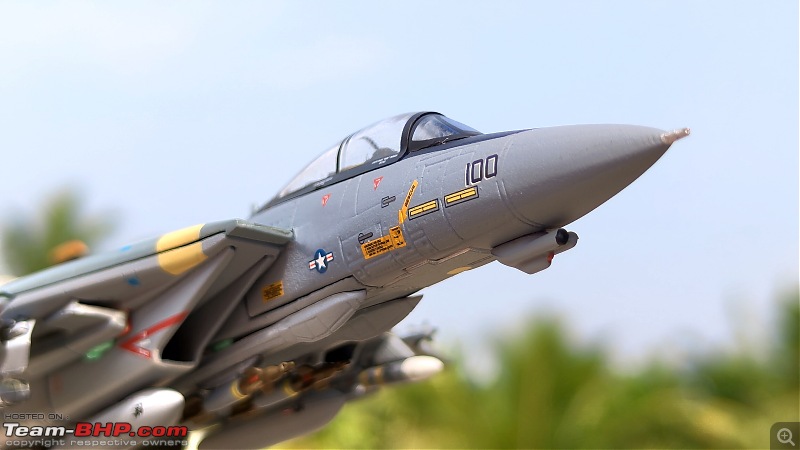1:144 Grumman F-14D Tomcat VF-31 "Tomcatters", US Navy, AJ100/ Bu No.164342, USS Theodore Roosevelt CVN-71 , Last Tomcat Cruise 2006
F-14D, Bu No. 164342 was delivered to the US Navy on Aug. 22, 1991. While serving with VF-31 (the last US Navy F-14 squadron), this F-14D participated in the last Tomcat cruise aboard the Roosevelt (CVN-71) and was one of the last US Navy F-14s to see combat in Iraq. It now resides at the Wings Over Miami Air Museum located at Kendall-Miami Airport, US.
The Super Tomcat
The ultimate evolution of the legendary Tomcat, the F-14D "Super Tomcat" was known for its enhanced capabilities over earlier A & B variants. Introduced in 1991, it boasted an advanced radar, targeting systems, and increased air-to-ground capabilities.
The F-14D was first delivered to the U.S. Navy in 1991, 17 years after the original F-14A Tomcat made her maiden flight. The F-14D had the following upgraded features over the earlier B varinat :
AN/APG-71 radar (which replaced the AWG-9 radar) & Glass cockpit
Airborne Self Protection Jammer
Joint Tactical Information Distribution System (JTIDS)
Low Altitude Navigation and Targeting Infrared for Night (LANTIRN) targeting system
SJU-17(V) Naval Aircrew Common Ejection Seats (NACES)
Infrared search and track (IRST)
Tactical Air Reconnaissance Pod System (TARPS)
Carrying capacity for four Joint Direct Attack Munitions (JADMs) (thus bolstering the fighter’s air-to-ground strike capabilities)
ROVER III Full Motion Video (FMV) (after 2005; not all D-models received this)
A total of 37 F-14D airframes were built from scratch, and for good measure, 18 of the F-14A specimens received D-model upgrades, and were thus re-designated the F-14D(R).
The F-14D’s last combat hurrah took place in a bombing mission carried out by two F-14Ds belonging to the aircraft USS Theodore Roosevelt (CVN-71) over Iraq on 8 February 2006. The Tomcat’s swan song in U.S. Navy service (not counting the Iranian Air Force, which still uses the plane to this day) took place on 14 September 2006, carried out by F-14D Bureau Number (BuNu)164603, number 711 of the 712 Tomcats built.
VF-31 Tomcatters 
US Navy Fighter Squadron 31 (VF-31) "Tomcatters" was the new designation given to VF-3A on August 7th, 1948. The squadron transitioned from the F6F Hellcat through the F9F Panther, F2H Banshee, F3H Demon and F-4 Phantom II before upgrading to the F-14 Tomcat in 1981. The Tomcatters deployed several times with the F-14 on various Nimitz Class carriers. They deployed with the F-14 for the last time aboard the USS Theodore Roosevelt in 2005 as part of Operation Iraqi Freedom. It was during this deployment that VF-31 became the last F-14 squadron to drop a bomb in combat. The squadron returned home in 2006 and and transitioned to the F/A-18E Super Hornet, being redesignated Strike Fighter Squadron 31 (VFA-31).

 General characteristics
General characteristics
Crew: 2 (Pilot and Radar Intercept Officer)
Length: 62 ft 9 in (19.13 m)
Wingspan: 64 ft 1.5 in (19.545 m)
Swept wingspan: 38 ft 2.5 in (11.646 m) swept
Height: 16 ft (4.9 m)
Wing area: 565 sq ft (52.5 m2) wings only
1,008 sq ft (94 m2) effective area including fuselage
Empty weight: 43,735 lb (19,838 kg)
Gross weight: 61,000 lb (27,669 kg)
Max takeoff weight: 74,350 lb (33,725 kg)
Fuel capacity: 16,200 lb (7,348 kg) internal fuel; 2 × optional 267 US gal (222 imp gal; 1,010 L) / 1,756 lb (797 kg) external drop tanks
Powerplant: 2 × General Electric F110-GE-400 afterburning turbofans, 16,333 lbf (72.65 kN) thrust each dry, 26,950 lbf (119.9 kN) with afterburner
Performance
Maximum speed: Mach 2.34 (1,544 mph, 2,485 km/h) at altitude
Mach 1.2, 794 kn (914 mph; 1,470 km/h) at sea level
Cruise speed: 420 kn (480 mph, 780 km/h)
Range: 1,600 nmi (1,800 mi, 3,000 km)
Combat range: 503 nmi (579 mi, 932 km) fighter escort
204 nmi (235 mi; 378 km) deck launched intercept
150 nmi (170 mi; 280 km) fleet air defense with 1.91 hours of loiter
Service ceiling: 53,000 ft (16,000 m) plus
g limits: +7.5 g (+6.5 g operational limit)
Rate of climb: 45,000 ft/min (230 m/s) plus
Wing loading: 96 lb/sq ft (470 kg/m2)
48 lb/sq ft (230 kg/m2) effective
Thrust/weight: 0.88 at gross weight (1.02 with loaded weight & 50% internal fuel)
Takeoff roll: 2,500 ft (760 m)
Landing roll: 2,400 ft (730 m)
Armament
Guns: 1× 20 mm (0.787 in) M61A1 Vulcan 6-barreled rotary cannon, with 675 rounds
Hardpoints: 10 total: 6× under-fuselage, 2× under nacelles and 2× on wing gloves with a capacity of 14,500 lb (6,600 kg) of ordnance and fuel tanks, with provisions to carry combinations of:
Rockets: 7x LAU-10 rocket pods (for a total of 28 rockets)
Missiles: AIM-54 Phoenix, AIM-7 Sparrow, AIM-9 Sidewinder air-to-air missiles
Bombs:
JDAM precision-guided munition (PGMs)
Paveway series of laser-guided bombs
Mk 80 series of unguided iron bombs
Mk 20 Rockeye II cluster munition
Other:
Tactical Airborne Reconnaissance Pod System (TARPS)
LANTIRN Targeting System (LTS) pod (AN/AAQ-14)
2× 267 US gal (1,010 L; 222 imp gal) drop tanks for extended range/loitering time
Avionics
Hughes AN/APG-71 radar
AN/ALR-67 radar warning receiver
AN/AAS-42 infrared search and track, AAX-1 TCS
AN/ASN-130 Inertial navigation system
Remotely Operated Video Enhanced Receiver (ROVER) upgrade











 1:144 F-14A VF-84 & F-14D VF-31
1:144 F-14A VF-84 & F-14D VF-31 





 (1)
Thanks
(1)
Thanks

 (4)
Thanks
(4)
Thanks

 (7)
Thanks
(7)
Thanks
 (3)
Thanks
(3)
Thanks
 (4)
Thanks
(4)
Thanks
 (7)
Thanks
(7)
Thanks

 (7)
Thanks
(7)
Thanks
 (4)
Thanks
(4)
Thanks

 (5)
Thanks
(5)
Thanks
 (3)
Thanks
(3)
Thanks
 (5)
Thanks
(5)
Thanks
 (3)
Thanks
(3)
Thanks

 (2)
Thanks
(2)
Thanks
 (1)
Thanks
(1)
Thanks









 . Since a hardware was offered and this Yank had prior service experience and had trained the pilots, he kind of got more personal than may have been US intent!
. Since a hardware was offered and this Yank had prior service experience and had trained the pilots, he kind of got more personal than may have been US intent!



























 . The Americans chose the Fairchild Republic A-10 over the Northrop A-9, while the Russians chose the Su-25 over the IL-102.
. The Americans chose the Fairchild Republic A-10 over the Northrop A-9, while the Russians chose the Su-25 over the IL-102.


